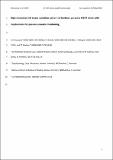Files in this item
High resolution three-dimensional beam radiation pattern of harbour porpoise clicks with implications for passive acoustic monitoring
Item metadata
| dc.contributor.author | MacAulay, Jamie Donald John | |
| dc.contributor.author | Malinka, Chloe Elizabeth | |
| dc.contributor.author | Gillespie, Douglas Michael | |
| dc.contributor.author | Madsen, Peter T. | |
| dc.date.accessioned | 2020-12-25T00:37:36Z | |
| dc.date.available | 2020-12-25T00:37:36Z | |
| dc.date.issued | 2020-06-25 | |
| dc.identifier | 268707015 | |
| dc.identifier | 39f40a40-e581-4dcd-816e-35206908744b | |
| dc.identifier | 85087473680 | |
| dc.identifier | 000545721300002 | |
| dc.identifier.citation | MacAulay , J D J , Malinka , C E , Gillespie , D M & Madsen , P T 2020 , ' High resolution three-dimensional beam radiation pattern of harbour porpoise clicks with implications for passive acoustic monitoring ' , Journal of the Acoustical Society of America , vol. 147 , no. 6 , pp. 4175-4188 . https://doi.org/10.1121/10.0001376 | en |
| dc.identifier.issn | 0001-4966 | |
| dc.identifier.other | ORCID: /0000-0001-9628-157X/work/76386657 | |
| dc.identifier.uri | https://hdl.handle.net/10023/21205 | |
| dc.description | Funding: Equipment and training time were funded by a Danish Research Council FNU grant to PTM. | en |
| dc.description.abstract | The source properties and radiation patterns of animal vocalisations define, along with propagation and noise conditions, the active space in which these vocalisations can be detected by conspecifics, predators, prey, and by passive acoustic monitoring (PAM). This study reports the 4π (360° horizontal and vertical) beam profile of a free-swimming, trained harbour porpoise measured using a 27-element hydrophone array. The forward echolocation beam is highly directional, as predicted by a piston model, and is consistent with previous measurements. However, at off-axis angles greater than ±30°, the beam attenuates more rapidly than the piston model and no side lobes are present. A diffuse back beam is also present with levels about −30 dB relative to the source level. In PAM, up to 50% of detections can be from portions of the beam profile with distorted click spectra, although this drops substantially for higher detection thresholds. Simulations of the probability of acoustically detecting a harbour porpoise show that a traditional piston model can underestimate the probability of detection compared to the actual three-dimensional radiation pattern documented here. This highlights the importance of empirical 4π measurements of beam profiles of toothed whales, both to improve understanding of toothed whale biology and to inform PAM. | |
| dc.format.extent | 14 | |
| dc.format.extent | 1434909 | |
| dc.language.iso | eng | |
| dc.relation.ispartof | Journal of the Acoustical Society of America | en |
| dc.subject | GC Oceanography | en |
| dc.subject | QH301 Biology | en |
| dc.subject | NDAS | en |
| dc.subject.lcc | GC | en |
| dc.subject.lcc | QH301 | en |
| dc.title | High resolution three-dimensional beam radiation pattern of harbour porpoise clicks with implications for passive acoustic monitoring | en |
| dc.type | Journal article | en |
| dc.contributor.institution | University of St Andrews. School of Biology | en |
| dc.contributor.institution | University of St Andrews. Sea Mammal Research Unit | en |
| dc.contributor.institution | University of St Andrews. Scottish Oceans Institute | en |
| dc.contributor.institution | University of St Andrews. Sound Tags Group | en |
| dc.contributor.institution | University of St Andrews. Bioacoustics group | en |
| dc.contributor.institution | University of St Andrews. Marine Alliance for Science & Technology Scotland | en |
| dc.identifier.doi | https://doi.org/10.1121/10.0001376 | |
| dc.description.status | Peer reviewed | en |
| dc.date.embargoedUntil | 2020-12-25 |
This item appears in the following Collection(s)
Items in the St Andrews Research Repository are protected by copyright, with all rights reserved, unless otherwise indicated.

